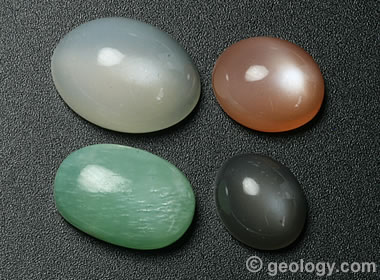
Colored Moonstone: Moonstone can occur in several different colors. Shown here, clockwise from top left: white moonstone cabochon measuring 16 x 12 millimeters; peach moonstone cabochon measuring 12 x 10 millimeters; gray moonstone cabochon measuring 11 x 9 millimeters; green moonstone cabochon measuring 15 x 10 millimeters. All of these cabs were cut from material mined in India.
What Is Moonstone?
Moonstone is the popular name used for gem-quality feldspar that exhibits the phenomenon of adularescence. Adularescence is a soft glow of light that appears to float just below the surface of a polished gemstone, usually a cabochon. The name "moonstone" was given because the floating light resembles the glow of the moon through a thin cloud cover.
The glow of moonstone is dynamic and appears to move within the stone when one of three things occurs: 1) the source of illumination moves, 2) the angle of observation is changed, or, 3) the gemstone is moved under the light. This beautiful and intriguing adularescence is what makes moonstone the most popular gemstone of the feldspar group.
Table of Contents
June Birthstone
Moonstone serves as a birthstone for the month of June. It is one of the orignial modern birthstones established in 1912. It shares the title of June birthstone with pearls and alexandrite.
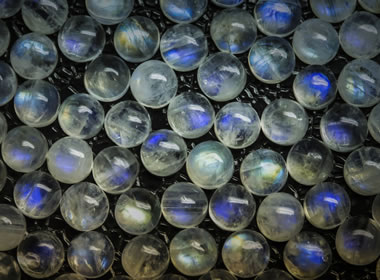
Moonstone: A scatter of round moonstone cabochons with blue flash adularescence. Image copyright iStockphoto / wirachai moontha.
Geologic and Geographic Origin
Sri Lanka is the world's most important source of fine-quality moonstone. Moonstone is also produced in significant quantities in Brazil, Myanmar and India. Small amounts are found in many other countries around the world.
Large, mechanized moonstone mines do not exist. Instead, most production is from artisinal mining. The miners prospect through stream sediments and gravels where moonstone is found, often along with a variety of other gems. A smaller amount is mined underground, where miners dig into soft kaolinite clay that developed as a residual material above weathering feldspar deposits and igneous rock masses.
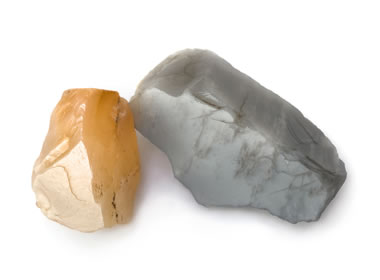
Rough Moonstone: Pieces of gray and peach moonstone before cutting. The glow of adularescence can be seen on the cleavage faces. Image copyright iStockphoto / J-Palys.
What Causes Adularescence?
Adularescence is observed in pieces of feldspar that contain thin alternating layers of orthoclase and albite. These micron-thick layers of different composition also have different refractive indexes. Light, penetrating one layer after another, is bent, reflected and scattered at the surface of each layer. The scattered light within the stone is what causes the adularescent glow and the beauty of the gem. Interlayering of other feldspars such as labradorite, oligoclase, or sanidine can also produce adularescence.
The term "adularescence" has its origin in Switzerland. Fine-quality moonstone was mined in the Swiss Alps, near the town of St. Gotthard Pass, formerly named Mt. Adular. The moonstone found there was called "adularia", named after the town. The name adularescence was used for the phenomena exhibited by the gem and the term spread by word of mouth and in print to gem dealers worldwide.
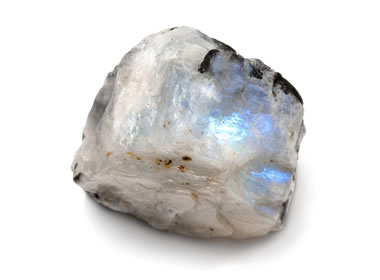
Blue Flash Rough: A specimen of uncut moonstone, exhibiting blue flash from beneath its cleavage faces. Image copyright iStockphoto / J-Palys.
Orienting a Cabochon
The most important job in cutting a moonstone cabochon is orienting the rough. This requires a knowledge of how light enters and behaves within the stone. The cutter must first identify the plane of adularescence. This plane will always be a parallel to a cleavage direction of the mineral.
Cleavage surfaces are then examined, looking for adularescence. Surfaces for one direction of cleavage will usually have much stronger adularescence than the other. Once that plane is identified, the flat base of the cabochon will be cut parallel to that plane. The cab should be approximately hemispherical in shape for a round stone, or a high loaf shape for an oval-cut stone.
Quartz-Moonstone Doublets
Moonstone is sometimes used to produce doublet cabochons. These are made by gluing a slab of quartz to a thin slice of blue flash moonstone. A cabochon is then cut from the material with the moonstone slice serving as the base of the cabochon. When these are properly cut and presented in jewelry the result is a cabochon with an apparent blue moonstone-like color and luster. These can be attractive. Their appeal is a much lower price than a moonstone cabochon. They have one advantage over moonstone cabochons - the quartz cap is a lot harder and suffers much less from abrasion and impact.
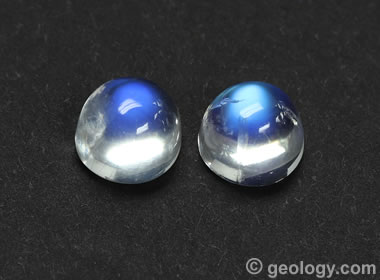
Blue Flash Moonstone: Two cabochons of blue flash moonstone. Each cab measures approximately 14 x 10 millimeters.
Adularescence and Bodycolor
Moonstone occurs in a wide range of bodycolors. These include white, gray, brown, pink, orange, green, yellow and colorless. Each of these bodycolors makes a beautiful gem. The adularescence is usually a white to silvery sheen.
Rarely, colorless specimens of feldspar will produce a spectacular blue adularescence. This phenomenon is often called "blue flash" or "blue sheen" adularescence. These specimens are rare and extremely desirable.
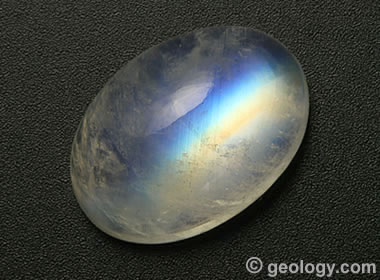
Rainbow Moonstone: A large cabochon of rainbow moonstone with strong adularescence cut from material mined in India. This stone measures 24 x 17 millimeters.
An even rarer occurrence is moonstone that exhibits a spectrum of iridescent colors. These specimens are known as "rainbow moonstone". This phenomenon occurs when white light is separated into its spectral colors while passing through the stone. The feldspar mineral labradorite is usually the source of these iridescent colors.
The quality of a moonstone cabochon is determined by several factors. A top-quality cabochon will have a pleasing bodycolor, excellent clarity, strong and symmetrical adularescence across the entire face of the gem, and a quality cutting job with a pleasing shape and excellent polish.
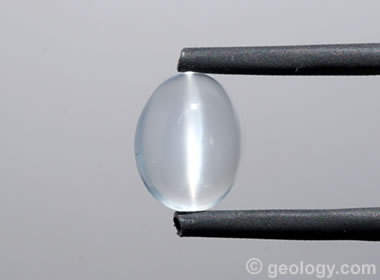
Cat's-Eye Moonstone: A transparent and colorless specimen of moonstone that exhibits a bright cat's-eye. The color and clarity of the stone, along with the strength of the chatoyance, make this a fine specimen of cat's-eye moonstone. This cabochon weighs 2.83 carats and measures 10.44 x 8.28 x 4.73 millimeters.
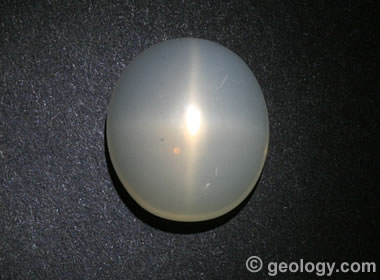
Star Moonstone: A translucent white moonstone cabochon that exhibits asterism through a white four-ray star. This stone weighs 11.16 carats and measures 15.2 x 13.4 x 7.5 millimeters.
Chatoyance and Asterism
Some specimens of moonstone can be cut to yield a cabochon that exhibits chatoyance (cat’s-eye moonstone) or four-ray asterism (star moonstone). When properly cut, gems that display these phenomena can be beautiful and highly desirable. An accompanying photo shows a very nice example of a transparent cat's-eye moonstone. Another accompanying photo shows a milky white moonstone cabochon that exhibits four-ray asterism.
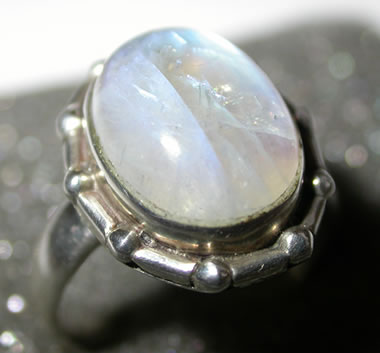
Moonstone Ring: Moonstone has perfect cleavage and can be easily damaged if used in a ring. One impact against a hard object can cleave the stone into two pieces. The stone in this ring has suffered that fate and received numerous bruises and abrasions. Photograph by Ra'ike, used here under a Creative Commons Attribution License.
Durability of Moonstone
Moonstone is a gem that is not suitable for everyday wear. It is not extremely hard and it cleaves easily, so care must be taken. Moonstone has a Mohs hardness of between 6 and 6.5, so it can be scratched by many common objects. Moonstone also has two directions of perfect cleavage, so it can be broken by a sharp impact.
Although moonstone rings are very popular, they are best worn at times when the risk of abrasion or impact is low. Moonstone makes wonderful earrings and pendants, and with these types of use the risk of damage is much lower. A setting that protects the gem can further reduce the risk of damaging moonstone jewelry.
| More Gemstones |
 |
Diamond |
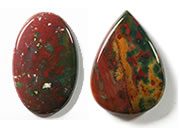 |
Bloodstone |
 |
Blue Gemstones |
 |
Tourmaline |
 |
Birthstones |
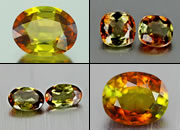 |
Andalusite |
 |
Rock Tumblers |
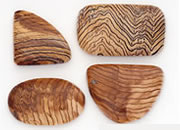 |
Opalized Wood |

Find Other Topics on Geology.com:

|

| ||

|

| ||

|

| ||

|

|

